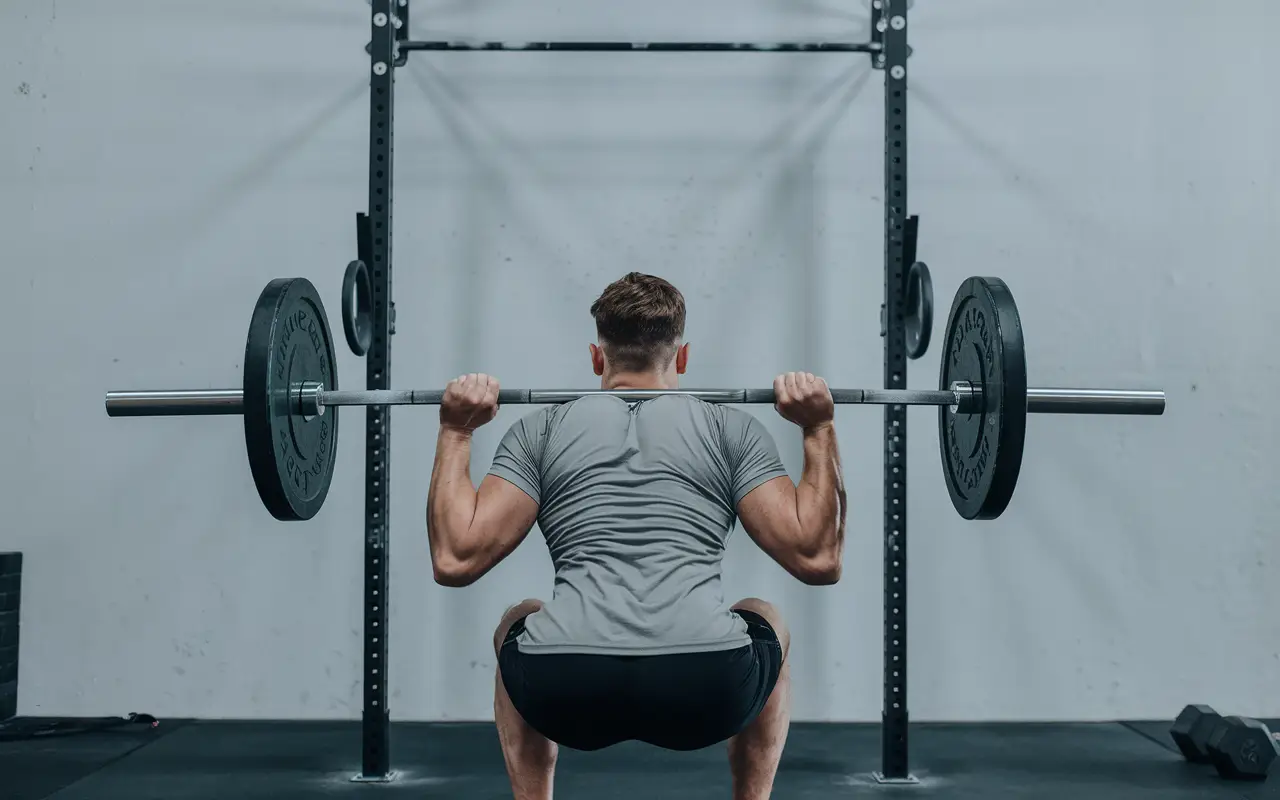Have you ever skipped leg day and regretted it later? Strong legs are essential for overall fitness, supporting daily movements, athletic performance, and injury prevention. Your leg muscles, quadriceps, hamstrings, glutes, and calves are crucial role in stability, posture, and power. Whether you’re an athlete, a gym-goer, or someone looking to improve mobility, focusing on leg workouts can enhance strength, endurance, and fat loss.
Let’s dive deeper into the best leg exercises and how to incorporate them into your routine!
In This Article
Anatomy of Leg Muscles
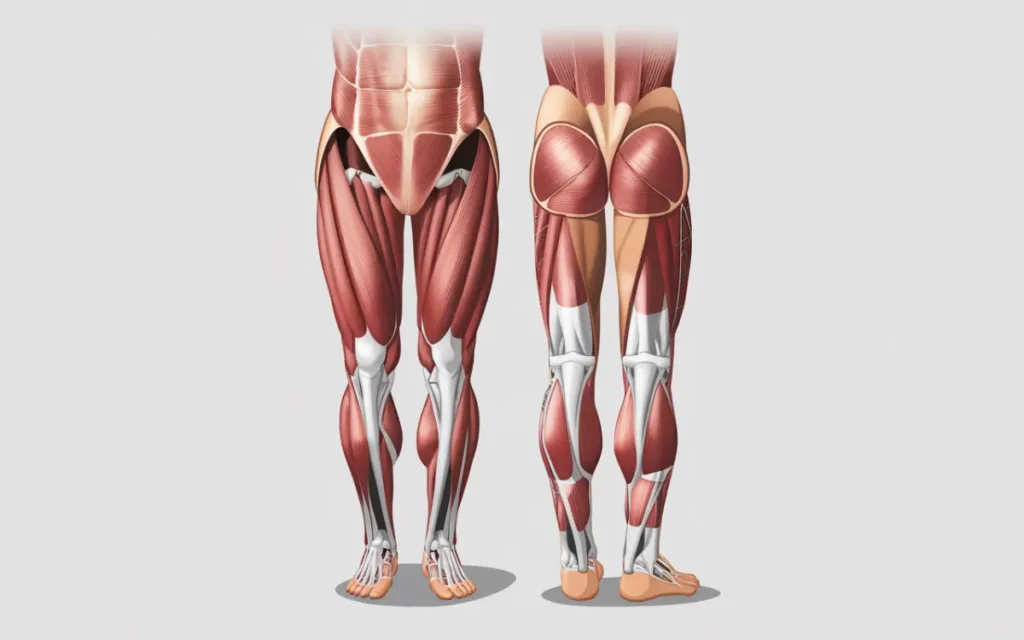
Before jumping into leg workouts, it’s essential to understand the major muscle groups involved. Your legs comprise several key muscles that work together for movement, stability, and strength.
1. Quadriceps (Quads)
The quadriceps are at the front of your thighs. They help you extend your knees. Strong quadriceps are necessary for squatting, running, and jumping.
2. Hamstrings
These muscles are at the back of your thighs and help with knee flexion and hip extension. Hamstrings are crucial for explosive movements like sprinting and deadlifts.
3. Gluteal Muscles (Glutes)
Your glutes, especially the gluteus maximus, are the powerhouse of your lower body. They contribute to hip stability, posture, and overall leg strength.
4. Calves
The calf muscles include the gastrocnemius and soleus. They aid ankle movement and provide the push-off power vital for walking, running, and jumping.
By targeting all these muscles effectively, you can improve overall lower-body strength and athletic performance.
Benefits of Leg Workouts
Many people focus on upper-body training, but leg workouts offer incredible benefits for overall fitness. Here’s why you shouldn’t skip leg day:
1. Increased Strength and Power
Strong legs provide the foundation for almost every movement, whether lifting weights, playing sports, or simply walking.
2. Better Athletic Performance
From running and jumping to changing direction quickly, powerful legs enhance speed, agility, and endurance.
3. Higher Calorie Burn
Leg workouts engage large muscle groups, increasing calorie expenditure and promoting fat loss. Compound movements like squats and lunges also boost metabolism.
4. Injury Prevention
Strengthening leg muscles enhances stability and lowers injury risks to the knee, hip, and lower back.
5. Improved Posture and Mobility
Strong legs support a better posture and help with daily movements like climbing stairs and carrying heavy loads.
Now that we’ve covered the importance of leg training, let’s explore some of the best exercises for building lower-body strength!
Bodyweight Leg Exercises
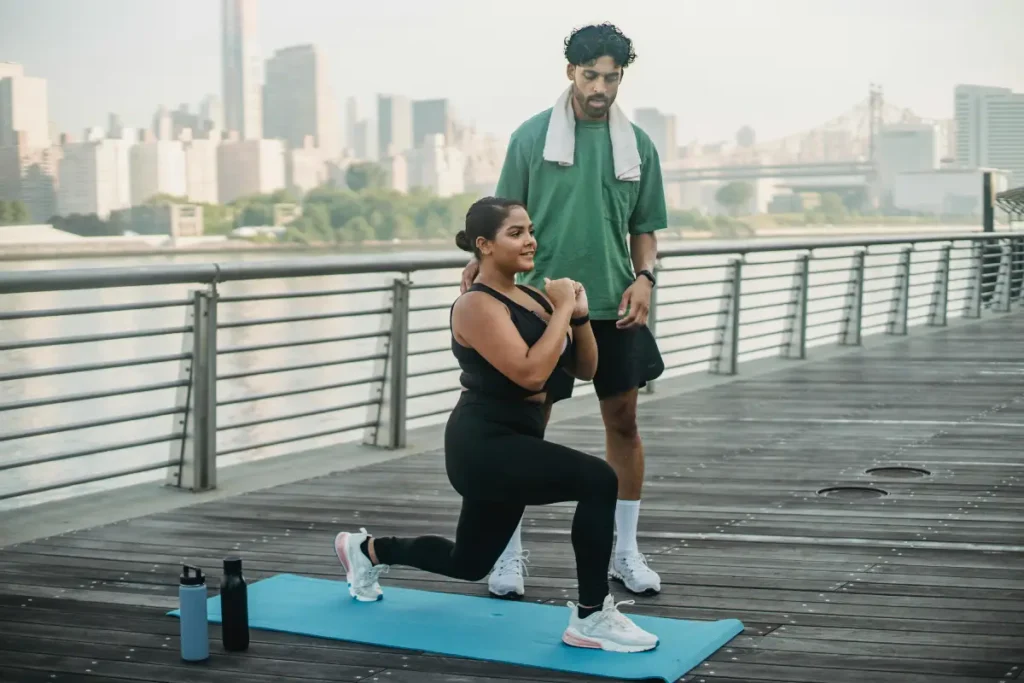
You don’t need fancy gym equipment to build strong legs. Bodyweight exercises can be as effective for muscle growth, endurance, and mobility. These movements can be done anywhere, making them perfect for beginners and advanced athletes.
1. Squats: The King of Leg Workouts
Squats are highly effective leg exercises that target the quadriceps, hamstrings, glutes, and core muscles.
How to Perform a Bodyweight Squat:
- Stand with feet shoulder-width apart.
- Lower your hips down and back as if sitting in a chair.
- Stand tall by keeping your chest up. Make sure your knees are in line with your toes.
- Press down through your heels to stand back up.
Benefits:
- Strengthens multiple leg muscles.
- Improves mobility and flexibility.
- Boosts balance and coordination.
2. Lunges: A Functional Movement
Lunges target each leg individually, improving balance and strengthening the quads, hamstrings, and glutes.
How to Perform a Forward Lunge:
- Stand straight and step forward with one leg.
- Bend your back knee towards the floor. Keep your front knee at a 90-degree angle.
- Push off with your front foot to return to standing.
- Repeat on the other leg.
Benefits:
- Improves lower-body stability.
- Enhances single-leg strength.
- Engages core muscles for balance.
3. Step-Ups: Building Power and Endurance
Step-ups mimic natural movement patterns like climbing stairs and are great for functional strength.
How to Perform Step-Ups:
- Find a sturdy bench or step.
- Stand on it with one foot and push down with your heel to lift yourself.
- Slowly lower back down and repeat on the other side.
Benefits:
- Develops explosive power.
- Strengthens glutes and quads.
- Enhances balance and coordination.
4. Calf Raises: Strengthening Lower Legs
Calves are crucial for walking, running, and jumping. Calf raises help build endurance and definition.
How to Perform Calf Raises:
- Stand with feet hip-width apart.
- Push down with the balls of your feet to lift your heels off the ground.
- Slowly lower back down.
Benefits:
- Improves ankle stability.
- Strengthens lower-leg muscles.
- Helps with athletic performance and endurance.
These bodyweight exercises are an excellent foundation for building leg strength.
Gym-Based Leg Exercises
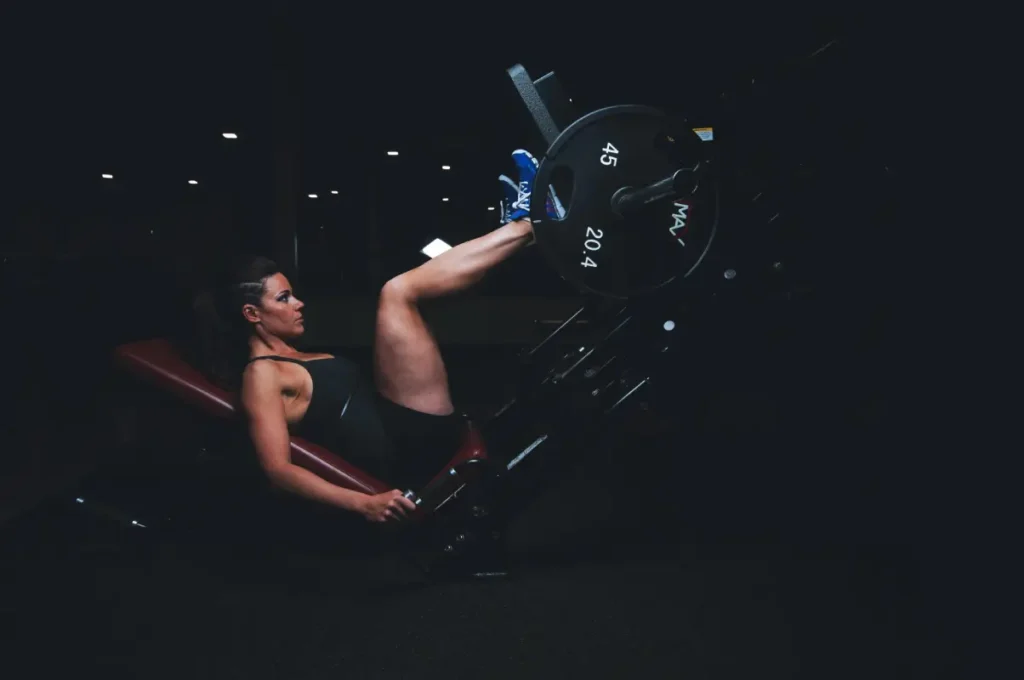
You can improve your leg workouts using a gym, machines, and free weights. These exercises help isolate muscles, improve strength, and add resistance to your training.
1. Leg Press: Targeting Quads and Glutes
The leg press machine builds lower-body strength while supporting your back.
How to Perform a Leg Press:
- Sit on the leg press machine. Position your feet shoulder-width apart on the platform.
- Lower the platform until your knees are at a right angle.
- Push the weight back up through your heels without locking your knees.
Benefits:
- Builds quad and glute strength.
- Reduces strain on the lower back.
- Allows for controlled movement with added resistance.
2. Leg Curls and Extensions: Isolating Hamstrings and Quads
Leg curl and leg extension machines are excellent for targeting individual muscle groups.
How to Perform Leg Curls (Hamstrings):
- Position yourself on the leg curl machine with your legs extended straight in front of you.
- Pull your feet back toward your glutes, squeezing your hamstrings.
- Slowly return to the starting position.
How to Perform Leg Extensions (Quads):
- Pose on the leg extension machine with your knees bent.
- Extend your legs straight while squeezing your quads.
- Lower back slowly without letting the weight drop.
Benefits:
- It isolates and strengthens specific muscles.
- It helps improve knee joint stability.
- Enhances muscle endurance.
3. Deadlifts: Building Overall Leg Strength
Deadlifts are highly effective compound exercises for the lower body, targeting the glutes, hamstrings, and lower back.
How to Perform a Deadlift:
- Position yourself with your feet shoulder-width apart, facing a barbell placed on the ground in front of you.
- As you prepare to lift, gracefully bend your hips and knees to secure a firm grip on the barbell.
- Push through your heels to lift the bar while extending your hips.
- Lower the bar back down with control.
Benefits:
- Builds strength in the posterior chain (glutes, hamstrings, and back).
- Improves posture and core stability.
- Enhances athletic performance and explosiveness.
4. Smith Machine Squats: Controlled Strength Training
The Smith machine provides guided movement, helping maintain proper squat form.
How to Perform a Smith Machine Squat:
- Position yourself with your feet shoulder-width apart, grounding yourself firmly beneath the bar. Feel the strength and stability as you prepare to embrace the challenge ahead.
- Bend your knees and gracefully lower your body into a squat, ensuring your chest remains lifted and proud.
- Push through your heels to return to standing.
Benefits:
- Provides stability and control.
- Reduces the risk of injury for beginners.
- Allows for heavier lifting with proper form.
Incorporating these gym-based exercises into your routine will help you build strong, well-defined legs. If you prefer free weights, let’s move on to the best leg workouts with barbells and dumbbells!
Leg Workouts with Weights
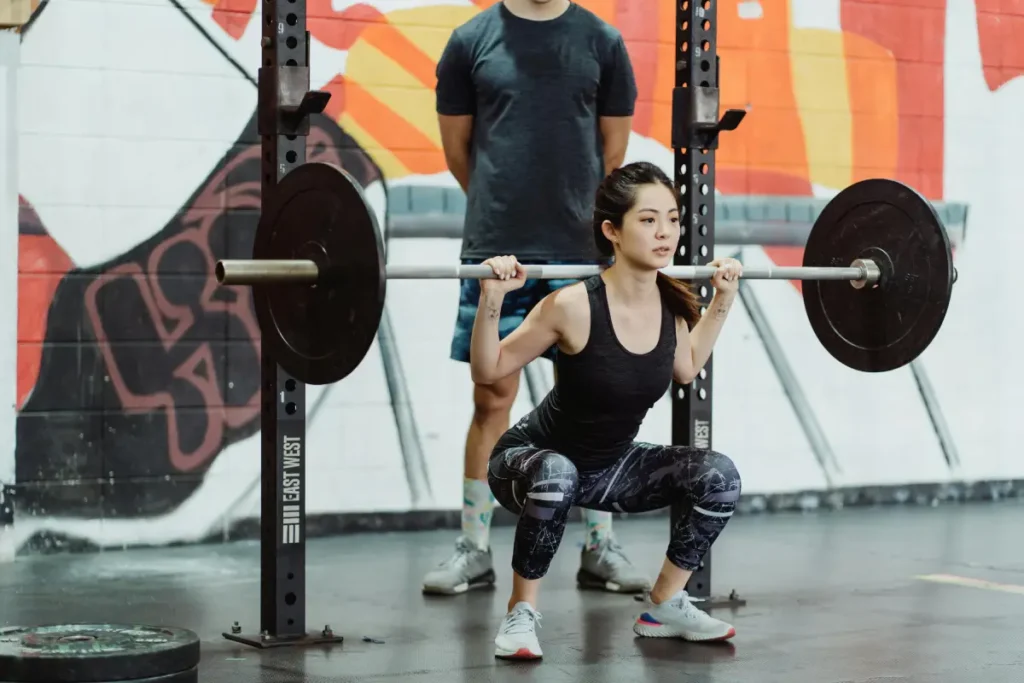
Adding weights to your leg workouts increases resistance, promoting muscle growth, strength, and endurance. Barbells or dumbbells help engage stabilizing muscles, improving balance and coordination.
1. Barbell Squats: Maximizing strength
Barbell squats are among the most effective lower-body exercises, engaging the quads, hamstrings, glutes, and core.
How to Perform a Barbell Squat:
- Stand with your feet shoulder-width apart and place a barbell across your upper back.
- Lower your hips down and back, keeping your chest up.
- Press through your heels to rise back into a standing position.
Benefits:
- Engages multiple muscle groups.
- Builds lower-body strength and core stability.
- Improves posture and mobility.
2. Bulgarian Split Squats: Unilateral Strength Training
This single-leg exercise helps improve balance, coordination, and muscle imbalances.
How to Perform a Bulgarian Split Squat:
- Stand in front of a bench and place one foot behind you on the bench.
- Bend your back knee toward the floor while ensuring your front knee remains aligned.
- Push through your front heel to return to standing.
Benefits:
- Enhances balance and coordination.
- Strengthens quads, glutes, and hamstrings.
- Reduces muscle imbalances.
3. Romanian Deadlifts: Hamstring and Glute Activation
This variation of the deadlift focuses more on hamstring and glute engagement.
How to Perform a Romanian Deadlift:
- Grab a barbell or dumbbell and hold it in front of your thighs.
- Hinge at your hips, lowering the weight while keeping your back straight.
- Squeeze your glutes to return to standing.
Benefits:
- Improves hamstring flexibility and strength.
- Builds posterior chain muscles.
- Enhances athletic performance.
These weighted exercises will add intensity to your leg workouts, helping you build stronger, more powerful legs. Now, let’s explore leg workouts specifically designed for athletes!
Best Leg Workouts for Beginners
Starting a leg workout routine can feel overwhelming, but focusing on fundamental exercises helps build strength, improve endurance, and prevent injury. Beginners should begin with controlled movements before progressing to heavier weights.
Beginner-Friendly Leg Workout Routine
| Exercise | Sets Reps | Rest Time |
|---|---|---|
| Bodyweight Squats | 3 12-15 | 30 sec |
| Lunges (Each Leg) | 3 10-12 | 30 sec |
| Step-Ups | 3 10 | 30 sec |
| Calf Raises | 3 15 | 30 sec |
| Glute Bridges | 3 12-15 | 30 sec |
1. Bodyweight Squats: Building a Strong Base
Squats are essential for strengthening the quads, hamstrings, and glutes. Beginners should focus on proper form before adding weights.
How to Progress:
- Start with bodyweight squats.
- Move to goblet squats with a dumbbell.
- Gradually increase weight as strength improves.
2. Lunges: Improving Balance and Strength
Lunges strengthen the legs while enhancing stability. Beginners should take controlled steps to maintain balance.
How to Progress:
- Start with static lunges.
- Advance to walking lunges.
- Add dumbbells for extra resistance.
3. Step-Ups: Enhancing Functional Strength
Step-ups mimic real-life movements, improving leg endurance and coordination. Beginners can use a low step and gradually increase the height.
4. Calf Raises: Strengthening the Lower Legs
Calf raises help with walking, running, and jumping. Beginners can perform them on a flat surface before progressing to a raised platform.
5. Glute Bridges: Activating the Posterior Chain
Glute bridges strengthen the glutes and hamstrings, which is essential for hip stability and lower-back support.
How to Progress:
- Start with bodyweight glute bridges.
- Advance to single-leg glute bridges.
- Add a weight plate for more resistance.
This beginner-friendly workout builds strength, improves mobility, and prepares the legs for more advanced exercises.
Advanced Leg Workouts
Advanced leg workouts incorporate heavier weights, increased intensity, and more challenging movement patterns for those looking to take their leg training to the next level. These workouts focus on hypertrophy (muscle growth), strength, and endurance.
High-Intensity Leg Workout Routine
| Exercise | Sets Reps | Rest Time |
|---|---|---|
| Barbell Back Squats | 4 6-8 | 60 sec |
| Bulgarian Split Squats | 4 10-12 | 45 sec |
| Romanian Deadlifts | 4 8-10 | 60 sec |
| Leg Press | 4 10-12 | 45 sec |
| Jump Squats | 3 12-15 | 30 sec |
1. Barbell Back Squats: Maximizing Leg Strength
Heavy squats stimulate overall muscle growth, increasing lower-body power and core engagement.
Advanced Progression:
- Use progressive overload (increase weight over time).
- Try pause squats to increase time under tension.
- Perform front squats for additional quad activation.
2. Bulgarian Split Squats: Improving Unilateral Strength
This movement enhances balance and isolates each leg to fix muscle imbalances.
Advanced Progression:
- Hold heavier dumbbells for more resistance.
- Elevate the front foot for a deeper range of motion.
- Slow down the eccentric (lowering) phase for more muscle activation.
3. Romanian Deadlifts: Hamstring and Glute Focus
This deadlift variation strengthens the posterior chain, improving hip mobility and explosiveness.
Advanced Progression:
- Use heavier weights while maintaining form.
- Perform single-leg Romanian deadlifts for balance and core engagement.
4. Leg Press: Building Quads and Glutes
The leg press allows for controlled, heavy lifting without spinal compression.
Advanced Progression:
- Use single-leg presses for isolation.
- Try slow negatives to increase muscle tension.
- Adjust foot placement to target different muscles (higher for glutes, lower for quads).
5. Jump Squats: Explosive Power and Endurance
Jump squats add a plyometric element, improving athletic performance and leg endurance.
Advanced Progression:
- Add weighted jump squats for increased difficulty.
- Perform depth jumps to enhance reactivity.
This high-intensity routine is perfect for advanced lifters looking to push their limits and build serious leg strength.
Leg Workouts for Fat Loss
Leg workouts are not just about building strength; they are also highly effective for burning fat. Since the legs contain some of the largest muscle groups in the body, training them increases calorie burn, boosts metabolism, and enhances overall fat loss.
How Leg Training Helps Burn Fat
- Engages Large Muscle Groups: Exercises like squats, lunges, and deadlifts activate multiple muscles, increasing energy expenditure.
- Increases Afterburn Effect (EPOC): Intense leg training raises post-workout oxygen consumption, meaning you burn calories even after exercising.
- Boosts Hormonal Response: Heavy leg exercises release testosterone and growth hormone, aiding in fat loss and muscle growth.
- Improves Cardiovascular Health: Compound leg movements improve heart rate and endurance, making workouts more effective for weight loss.
Best Leg Exercises for Fat Loss
| Exercise | Sets Reps | Rest Time |
|---|---|---|
| Jump Squats | 4 15-20 | 30 sec |
| Walking Lunges | 4 12-15 | 30 sec |
| Romanian Deadlifts | 3 10-12 | 45 sec |
| Step-Ups | 3 12 | 30 sec |
| Calf Raises | 3 15-20 | 30 sec |
1. Jump Squats: High-Intensity Fat Burner
Explosive movements like jump squats elevate heart rate and torch calories.
Fat Loss Tip:
- Perform jump squats in circuit training for maximum calorie burn.
2. Walking Lunges: Full-Leg Activation
Walking lunges engage the quads, hamstrings, and glutes while improving balance.
Fat Loss Tip:
- Add dumbbells for extra resistance and higher energy expenditure.
3. Romanian Deadlifts: Muscle Building & Fat Loss
This exercise strengthens the posterior chain while helping maintain muscle mass during weight loss.
4. Step-Ups: Functional Movement for Fat Burning
Step-ups mimic real-life activities, improving endurance and lower-body strength.
Fat Loss Tip:
- Perform step-ups at a faster pace to increase cardiovascular benefits.
5. Calf Raises: Toning and Defining Lower Legs
Though not as intense as squats, calf raises help to sculpt the lower legs and improve endurance.
Counting these workouts to your workout can help you lose fat faster and strengthen your lower body.
Common Leg Workout Mistakes
Even the best leg workouts can be ineffective if performed incorrectly. Poor form, overtraining, and neglecting recovery can lead to injuries and hinder progress. Avoid these common mistakes to maximize your leg training results.
1. Overtraining & Poor Recovery
Many lifters push too hard without allowing their muscles to recover. Overtraining can lead to fatigue, joint pain, and decreased performance.
How to Avoid It:
- Train legs 2-3 times per week with proper rest days in between.
- Prioritize sleep, hydration, and nutrition for muscle recovery.
- Listen to your body, and rest a day extra if you feel excessive soreness.
2. Ignoring Proper Form
Bad form reduces effectiveness and increases the chance of injuries, particularly to the knees and lower back.
How to Fix It:
- Perform exercises with slow, controlled movements.
- Make sure your knees align with your toes while performing squats and lunges.
- Engage your core to maintain stability in all movements.
3. Not Training the Entire Leg
Many focus only on quads while neglecting hamstrings, glutes, and calves. This can lead to imbalances and increased injury risk.
How to Balance Your Training:
- Incorporate posterior chain exercises like deadlifts, Romanian deadlifts, and glute bridges.
- Train calves regularly to maintain lower-leg strength and endurance.
- Mix compound and isolation exercises for complete leg development.
4. Using Too Much or Too Little Weight
Lifting too heavy with bad form can cause injuries, while using too little weight may not challenge your muscles enough.
How to Find the Right Weight:
- Use a weight that allows you to complete reps with good form while feeling challenged.
- Gradually increase weight as your strength improves (progressive overload).
- Prioritizing quality over quantity means proper execution matters more than lifting heavy weights.
5. Skipping Warm-Up and Stretching
Failing to warm up before training can lead to stiffness and injuries while skipping post-workout stretching can result in tight muscles.
How to Fix It:
- Start with dynamic warm-ups like leg swings, bodyweight squats, and lunges.
- Stretch after your workout to enhance flexibility and prevent soreness.
- Utilize foam rolling to relieve muscle tightness and support recovery.
Avoiding these common mistakes will help you get the most out of your leg workouts while preventing injuries.
Stretching and Recovery for Legs
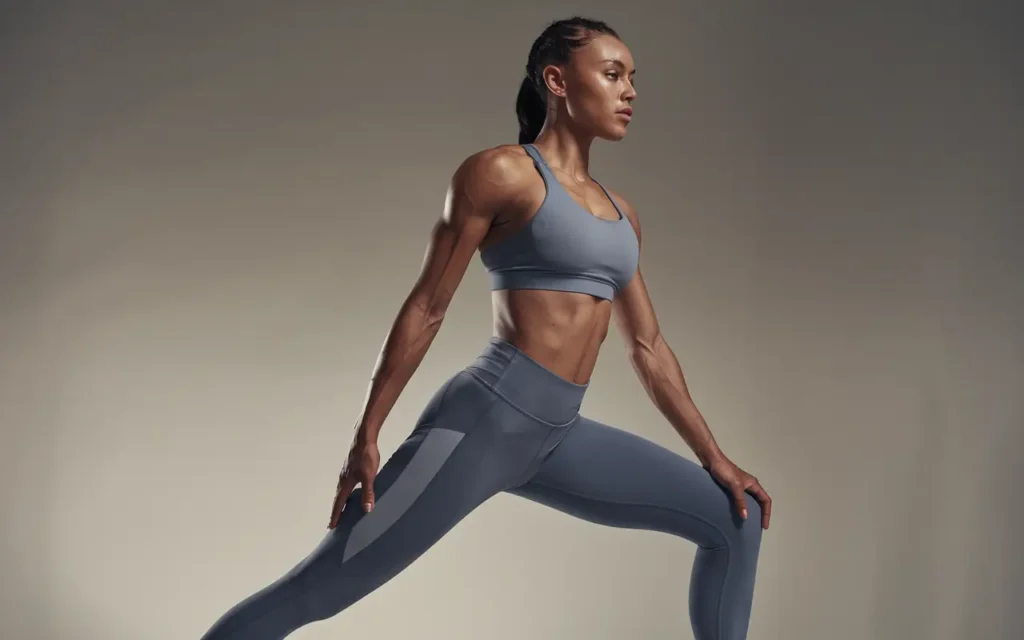
Recovery is equally important as the workout itself. Proper stretching, foam rolling, and rest ensure muscle growth, reduce soreness, and prevent injuries. Let’s explore the best recovery methods for your legs.
1. Importance of Post-Workout Stretching
Stretching after leg workouts helps maintain flexibility, improve mobility, and reduce muscle tightness.
Best Post-Workout Stretches for Legs:
- Quad Stretch: Stand on one leg, pull your opposite foot toward your glutes, and hold.
- Hamstring Stretch: Gently extend one leg in front of you and reach for your toes. Embrace the stretch, allowing yourself to appreciate the sensation as you hold this position entirely.
- Calf Stretch: Press your heel into the ground while leaning against a wall.
- Hip Flexor Stretch: Lunge forward, extending your back leg to stretch the hip flexors.
Stretching Tips:
- Hold each stretch for 20-30 seconds.
- Breathe deeply to relax the muscles.
- Avoid bouncing, as it can cause strain.
2. Foam Rolling for Muscle Recovery
Foam rolling (self-myofascial release) helps reduce muscle tightness and improve circulation.
Best Foam Rolling Techniques for Legs:
- Quads: Roll from your hip to your knee while applying light pressure.
- Hamstrings: Sit on the roller and move back and forth under your thighs.
- Calves: Place the roller under your calves and gradually roll from the ankle to the knee.
- IT Band: Lie on your side and roll along the outer thigh, moving from the hip to the knee.
Foam Rolling Tips:
- Spend at least 30-60 seconds on each muscle.
- Apply moderate pressure without causing sharp pain.
- Use slow, controlled movements.
3. Proper Nutrition for Muscle Recovery
A balanced diet is vital for muscle repair and growth.
What to Eat After a Leg Workout:
- Protein: Helps repair and rebuild muscle fibers (chicken, fish, eggs, plant-based protein).
- Carbohydrates: Replenishes glycogen stores for energy (rice, potatoes, whole grains).
- Healthy Fats: Supports muscle recovery and joint health (avocado, nuts, olive oil).
- Hydration: Water and electrolytes prevent cramps and dehydration.
4. Rest and Sleep for Muscle Growth
Muscles grow and recover during rest, not just during workouts.
Tips for Better Recovery:
- Aim for 7-9 hours of sleep per night.
- Take rest days between intense leg sessions.
- Use active recovery (light walking, yoga) to improve blood flow.
By prioritizing recovery, you’ll experience better performance, reduced soreness, and stronger legs.
FAQs on Leg Workouts
Bodyweight squats are the best starting point. They build strength, improve balance, and teach proper form before progressing to weighted exercises. Lunges and step-ups are also great beginner-friendly movements.
Training legs 2-3 times weekly is ideal for muscle growth and strength. Beginners can start twice a week, while advanced lifters may benefit from three intense sessions incorporating different exercises daily.
Yes! Stronger legs improve stride power and efficiency. Exercises like squats, deadlifts, lunges, and plyometrics enhance explosive strength, leading to faster acceleration and better endurance.
Mild soreness (DOMS) is normal and can be managed with light activity like stretching or walking. However, if soreness is severe, allow extra recovery time to prevent overtraining and injury.
Squats are a fantastic compound movement but shouldn’t be the only leg exercise. To ensure balanced development, a complete routine should include hamstring, calf, and glute exercises like Romanian deadlifts, lunges, and calf raises.
Conclusion
Leg workouts are crucial for building strength, enhancing athletic performance, and maintaining overall health. Whether a beginner or an advanced lifter, incorporating various exercises, bodyweight movements, weighted squats, plyometrics, and agility drills will help you achieve robust, well-developed legs.
Focusing on proper form, balanced training, and recovery will maximize results while reducing the risk of injury. Don’t skip leg day; your body will thank you for it!
Connect with us on Facebook and Instagram for a daily dose of inspiration and exciting updates! Join our vibrant community and be part of the conversation!

